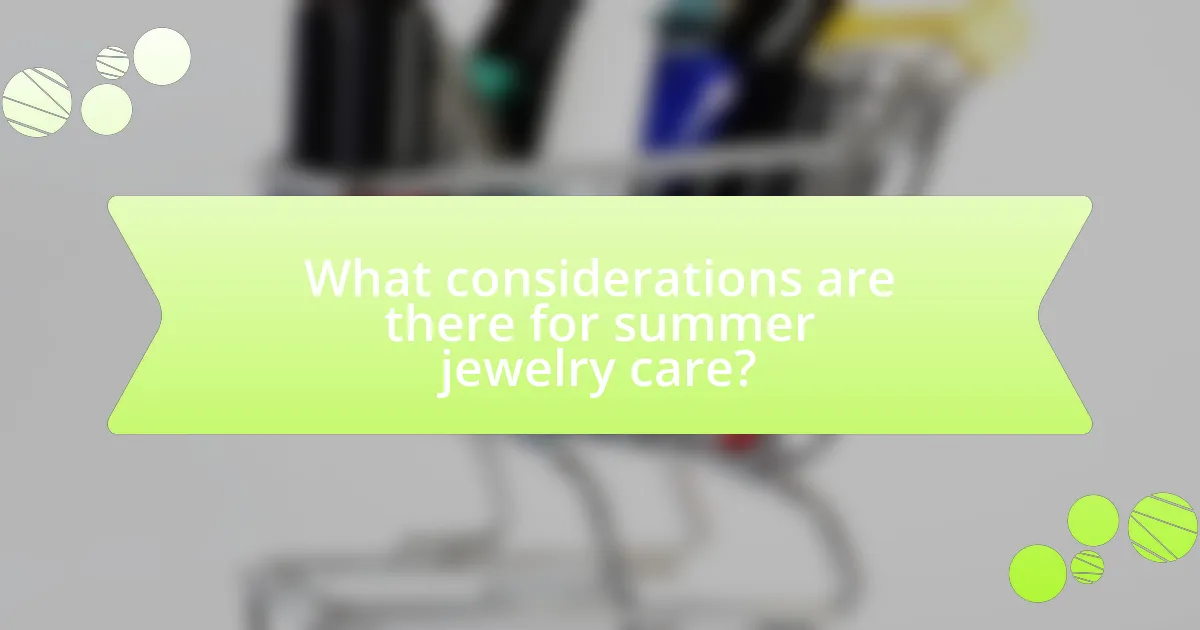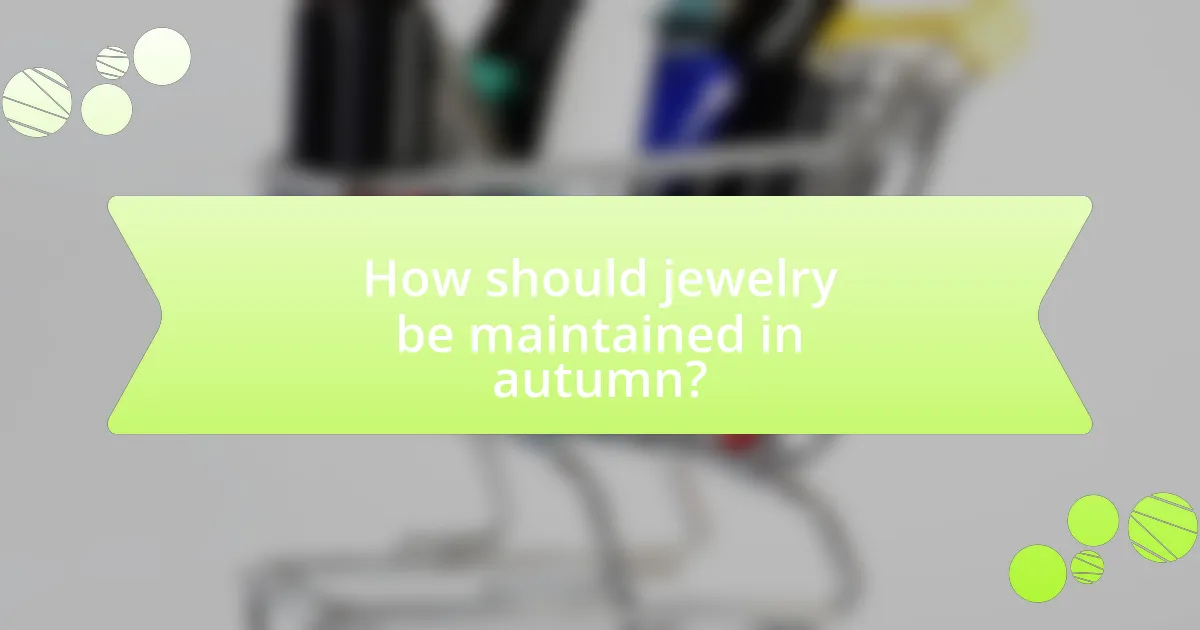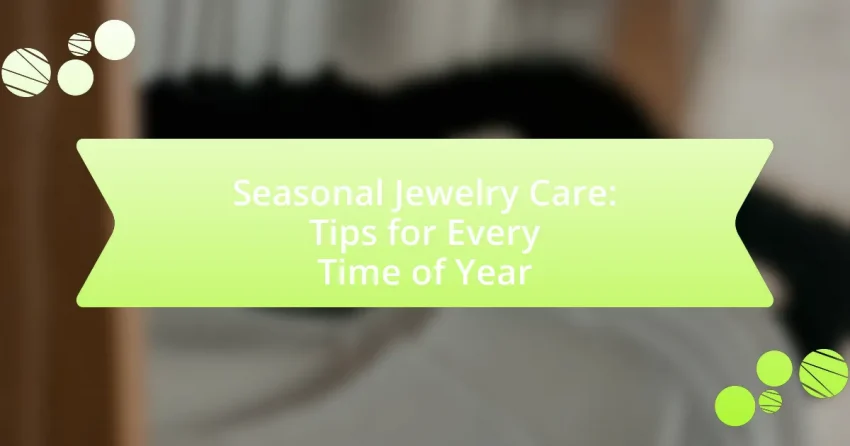Seasonal jewelry care encompasses maintenance and storage practices tailored to the changing weather conditions throughout the year. This article outlines the importance of seasonal care, detailing how different seasons affect various types of jewelry, including metals and gemstones, and the risks associated with neglecting proper care. It provides guidelines for cleaning and storing jewelry effectively, emphasizing the need for specific practices during winter, spring, summer, and autumn. Additionally, the article highlights common mistakes to avoid and signs that indicate when professional attention is necessary, ensuring that jewelry remains in optimal condition year-round.

What is Seasonal Jewelry Care?
Seasonal jewelry care refers to the specific maintenance and storage practices applied to jewelry based on seasonal changes. This approach ensures that jewelry remains in optimal condition, as different weather conditions can affect materials like metals, gemstones, and pearls. For instance, during summer, increased humidity can lead to tarnishing of metals, while winter’s dry air may cause certain materials to become brittle. Proper seasonal care includes cleaning, storing jewelry in appropriate environments, and avoiding exposure to harsh elements, which helps preserve the integrity and appearance of the pieces over time.
Why is it important to care for jewelry seasonally?
Caring for jewelry seasonally is important to maintain its appearance and longevity. Different seasons expose jewelry to varying environmental factors such as humidity, temperature changes, and exposure to chemicals, which can cause tarnishing, damage, or deterioration. For instance, summer heat and humidity can lead to increased moisture that promotes tarnishing in metals, while winter dryness can cause certain materials to become brittle. Regular seasonal care, including cleaning and proper storage, helps prevent these issues, ensuring that jewelry remains in optimal condition and retains its value over time.
How do seasonal changes affect different types of jewelry?
Seasonal changes significantly affect different types of jewelry by influencing their materials, wearability, and maintenance needs. For instance, in winter, colder temperatures can cause metal to contract, potentially leading to loose stones in rings, while moisture can lead to tarnishing in silver jewelry. In contrast, summer heat can expand metals, making rings feel tighter and increasing the risk of loss. Additionally, exposure to sunlight can fade gemstones and damage certain materials like pearls, which are more sensitive to environmental changes. Therefore, understanding these seasonal impacts is crucial for proper jewelry care and longevity.
What are the risks of neglecting seasonal jewelry care?
Neglecting seasonal jewelry care can lead to significant risks, including damage to the jewelry’s materials, loss of luster, and potential for irreversible deterioration. For instance, exposure to moisture and humidity during summer can cause tarnishing in metals and damage to gemstones, while winter conditions may lead to cracking or brittleness in certain materials. Additionally, improper storage can result in scratches and entanglement, further compromising the integrity of the pieces. Regular maintenance, such as cleaning and proper storage, is essential to preserve the quality and longevity of jewelry, as evidenced by industry standards that recommend routine care to prevent these issues.
What are the general principles of jewelry care?
The general principles of jewelry care include regular cleaning, proper storage, and avoiding exposure to harsh chemicals. Regular cleaning helps maintain the shine and integrity of the jewelry, while proper storage prevents scratches and tangling. Avoiding harsh chemicals, such as those found in household cleaners, protects the materials from damage. For instance, using a soft cloth to wipe jewelry after wearing it can remove oils and dirt, and storing pieces in a fabric-lined box can minimize exposure to air and moisture, which can lead to tarnishing.
How can proper storage enhance jewelry longevity?
Proper storage enhances jewelry longevity by preventing damage from environmental factors and physical wear. Storing jewelry in a cool, dry place reduces exposure to humidity, which can cause tarnishing and corrosion, particularly in metals like silver and copper. Additionally, using individual compartments or soft pouches prevents pieces from scratching each other, preserving their finish and structural integrity. Research indicates that proper storage methods can extend the lifespan of jewelry significantly, as items kept in optimal conditions show less deterioration over time.
What cleaning methods are safe for various materials?
Safe cleaning methods for various materials include using mild soap and water for gold and silver, a specialized jewelry cleaner for gemstones, and a soft cloth for pearls. Gold and silver can be cleaned effectively with a mixture of warm water and a few drops of dish soap, ensuring no harsh chemicals are used that could damage the metal. Gemstones often require specific cleaners that are pH-balanced to avoid deterioration; for example, a gentle jewelry cleaner designed for the specific type of stone is recommended. Pearls should only be wiped with a soft, damp cloth to prevent scratching and should never be submerged in water, as this can weaken the string and damage the luster. These methods are validated by jewelry care guidelines from reputable sources such as the Gemological Institute of America, which emphasizes the importance of using appropriate cleaning techniques to maintain the integrity of various materials.

How should jewelry be cared for in winter?
Jewelry should be cared for in winter by keeping it dry and avoiding exposure to harsh weather conditions. Moisture from snow and rain can cause tarnishing and damage to various metals and gemstones. Additionally, it is advisable to store jewelry in a cool, dry place and to clean it regularly with a soft cloth to remove any moisture or dirt that may accumulate. This practice helps maintain the jewelry’s shine and prevents corrosion, ensuring its longevity during the winter months.
What specific challenges does winter pose for jewelry?
Winter poses specific challenges for jewelry, primarily due to cold temperatures and increased moisture. Cold weather can cause metal to contract, potentially leading to structural weaknesses in pieces, while moisture from snow and rain can lead to tarnishing and corrosion, especially in non-precious metals. Additionally, wearing jewelry in winter can result in skin irritation due to dry air, which can affect the wearability of certain pieces. These factors necessitate careful storage and maintenance practices to preserve the integrity and appearance of jewelry during the winter months.
How can moisture and cold affect metal and gemstones?
Moisture and cold can cause corrosion in metals and damage to gemstones. Metals, particularly those that are not precious, can oxidize when exposed to moisture, leading to rust or tarnish. For example, iron and copper are highly susceptible to corrosion in humid conditions. Gemstones can also be affected; for instance, extreme cold can cause thermal shock, leading to cracks in stones like opal or quartz. Additionally, moisture can lead to the growth of mold or mildew on organic gemstones such as pearls, compromising their integrity.
What protective measures can be taken during winter?
Protective measures that can be taken during winter include storing jewelry in a dry, insulated environment to prevent moisture damage and avoiding exposure to harsh chemicals such as salt and antifreeze. Jewelry should be cleaned regularly with a soft cloth to remove any residue that may accumulate from winter activities. Additionally, wearing protective gloves while handling jewelry can minimize the risk of scratches and damage. These measures help maintain the integrity and appearance of jewelry during the winter months.
What are the best practices for cleaning jewelry in winter?
The best practices for cleaning jewelry in winter include using a gentle cleaning solution, avoiding harsh chemicals, and ensuring thorough drying to prevent moisture-related damage. Jewelry can accumulate dirt and grime during winter due to increased exposure to lotions and oils from clothing. A mixture of warm water and mild dish soap is effective for cleaning most types of jewelry. After soaking for a few minutes, gently scrub with a soft brush, then rinse with clean water. It is crucial to dry the jewelry completely with a soft cloth to prevent tarnishing or corrosion, especially for pieces made of silver or other reactive metals. Regular maintenance during winter helps preserve the jewelry’s appearance and longevity.
Which cleaning solutions are effective yet safe for winter care?
Effective and safe cleaning solutions for winter jewelry care include a mixture of warm water and mild dish soap, as well as a solution of equal parts white vinegar and water. These solutions are gentle enough to avoid damaging delicate materials while effectively removing dirt and tarnish. The warm soapy water can dissolve grime without harsh chemicals, and the vinegar solution is known for its ability to cut through tarnish on metals like silver. Both methods are widely recommended by jewelers for maintaining the integrity and appearance of jewelry during the winter months.
How often should jewelry be cleaned during winter months?
Jewelry should be cleaned every two to four weeks during the winter months. This frequency is recommended because winter conditions, such as dry air and exposure to lotions or perfumes, can lead to a buildup of residue on jewelry. Regular cleaning helps maintain the jewelry’s appearance and prevents long-term damage.

What are the best jewelry care tips for spring?
The best jewelry care tips for spring include cleaning, storing, and protecting your jewelry from environmental factors. Regularly clean your jewelry with a soft cloth to remove dirt and oils, as spring activities can lead to increased exposure to moisture and grime. Store jewelry in a cool, dry place, ideally in a fabric-lined box or pouches to prevent scratches and tangling. Additionally, avoid wearing jewelry while gardening or engaging in outdoor activities to minimize exposure to dirt and chemicals. These practices help maintain the integrity and appearance of your jewelry during the spring season.
How does spring weather impact jewelry maintenance?
Spring weather impacts jewelry maintenance primarily due to increased humidity and temperature fluctuations. These conditions can lead to tarnishing of metals and degradation of certain materials, such as pearls and leather. Humidity can cause moisture to accumulate on jewelry, promoting oxidation and tarnish, particularly in silver and copper alloys. Additionally, warmer temperatures can exacerbate the effects of sweat and body oils on jewelry, necessitating more frequent cleaning and maintenance. Regularly inspecting and cleaning jewelry during spring can help mitigate these effects and preserve its appearance and integrity.
What types of jewelry are most affected by spring humidity?
Spring humidity most significantly affects jewelry made from materials such as silver, copper, and certain gemstones. These materials are prone to tarnishing and corrosion when exposed to high moisture levels. For instance, silver jewelry can develop a layer of tarnish due to the reaction between silver and sulfur compounds in the air, which is exacerbated by humidity. Similarly, copper can oxidize, leading to discoloration. Gemstones like opals and pearls can also absorb moisture, which may affect their luster and structural integrity.
How can you protect jewelry from springtime activities?
To protect jewelry from springtime activities, store it in a secure, dry place and avoid wearing it during outdoor activities that may cause damage. Spring activities often involve gardening, sports, or water-related events, which can expose jewelry to dirt, moisture, and physical impact. For instance, removing rings and bracelets before gardening prevents scratches and dirt accumulation, while keeping jewelry away from water activities reduces the risk of tarnishing and loss. Additionally, using a jewelry box with compartments can help prevent tangling and scratching, ensuring that pieces remain in good condition throughout the season.
What cleaning routines should be followed in spring?
Spring cleaning routines for jewelry should include thorough inspection, gentle cleaning, and proper storage. Inspect each piece for any signs of damage, such as loose stones or tarnishing. Use a soft cloth or a specialized jewelry cleaner to gently clean the items, ensuring that you avoid harsh chemicals that can damage delicate materials. After cleaning, store jewelry in a cool, dry place, preferably in individual pouches or a jewelry box with compartments to prevent scratching and tangling. Regular maintenance during spring helps preserve the integrity and appearance of jewelry, ensuring it remains in optimal condition.
What natural cleaning agents can be used for spring cleaning?
Natural cleaning agents that can be used for spring cleaning include vinegar, baking soda, lemon juice, and castile soap. Vinegar is effective for cutting grease and disinfecting surfaces due to its acetic acid content. Baking soda acts as a gentle abrasive and deodorizer, making it suitable for scrubbing surfaces without scratching them. Lemon juice has natural antibacterial properties and can help remove stains and odors. Castile soap, made from vegetable oils, is a versatile cleaner that can be used on various surfaces. These agents are not only effective but also environmentally friendly alternatives to chemical cleaners.
How can you prepare jewelry for summer after spring?
To prepare jewelry for summer after spring, clean and store pieces properly to prevent damage from heat and humidity. Cleaning involves using a soft cloth to remove dirt and oils, and for deeper cleaning, a mild soap solution can be used for metal and gemstones, ensuring they are thoroughly dried afterward. Storing jewelry in a cool, dry place, preferably in anti-tarnish pouches or boxes, helps maintain their condition. Additionally, avoid exposing jewelry to chlorine and saltwater, as these can cause corrosion and damage. Regular maintenance and proper storage are essential for preserving the integrity of jewelry during the summer months.

What considerations are there for summer jewelry care?
Summer jewelry care requires specific considerations to protect pieces from heat, humidity, and exposure to water. High temperatures can cause certain materials, like plastics and resins, to warp or discolor, while humidity can lead to tarnishing of metals. Additionally, exposure to chlorine in pools and saltwater at the beach can damage jewelry, particularly those with gemstones or delicate settings. To mitigate these risks, it is advisable to store jewelry in a cool, dry place, remove pieces before swimming, and clean them regularly with appropriate solutions to maintain their luster.
How do heat and sun exposure affect jewelry?
Heat and sun exposure can cause significant damage to jewelry, particularly those made from sensitive materials. High temperatures can lead to the warping or melting of certain plastics and resins used in jewelry, while prolonged sun exposure can fade the color of gemstones and metals, diminishing their aesthetic appeal. For instance, pearls can become discolored and lose their luster when exposed to excessive heat and sunlight. Additionally, heat can weaken the structural integrity of certain settings, making them more prone to breakage. Therefore, it is essential to store jewelry in a cool, shaded place to preserve its quality and longevity.
What types of jewelry are most vulnerable to summer conditions?
Gold and silver jewelry are most vulnerable to summer conditions due to increased humidity and exposure to sweat. Humidity can cause tarnishing in silver, while sweat can lead to discoloration and damage to both gold and silver pieces. Additionally, costume jewelry, which often contains non-precious metals and coatings, is particularly susceptible to corrosion and fading when exposed to moisture and heat. Studies have shown that prolonged exposure to sweat can significantly reduce the lifespan of such jewelry, making it essential to take care when wearing these items during the summer months.
How can you prevent damage from sweat and chlorine?
To prevent damage from sweat and chlorine, regularly clean your jewelry and apply a protective coating. Cleaning removes residues that can cause tarnishing, while a protective coating, such as a clear nail polish, creates a barrier against corrosive elements. Studies show that chlorine can significantly degrade metals like gold and silver, leading to discoloration and structural weakness. Therefore, maintaining cleanliness and applying protective measures are essential for preserving the integrity of your jewelry.
What are the recommended cleaning practices for summer?
The recommended cleaning practices for summer include regularly cleaning jewelry with a mild soap solution and a soft brush to remove sweat and sunscreen residue. This is essential because summer activities often expose jewelry to elements that can cause tarnishing or damage. Additionally, storing jewelry in a cool, dry place helps prevent moisture-related issues. Regular maintenance, such as checking for loose stones or clasps, is also advised to ensure the longevity of the pieces during the summer months.
How can you safely clean jewelry after beach or pool use?
To safely clean jewelry after beach or pool use, rinse the jewelry under lukewarm running water to remove salt, chlorine, and sand. This method effectively eliminates harmful residues that can cause tarnishing or damage. Following the rinse, gently scrub the jewelry with a soft toothbrush and mild soap to ensure thorough cleaning without scratching the surface. This approach is validated by jewelers who recommend regular cleaning to maintain the integrity and appearance of jewelry exposed to harsh elements.
What storage tips are best for summer jewelry care?
To ensure optimal summer jewelry care, store jewelry in a cool, dry place away from direct sunlight and humidity. High temperatures and moisture can cause tarnishing and damage to various materials, including metals and gemstones. Using anti-tarnish pouches or cloths can further protect jewelry from oxidation. Additionally, keeping pieces separated in soft pouches or compartments prevents scratching and tangling, preserving their condition. These practices are essential for maintaining the integrity and appearance of jewelry during the summer months.

How should jewelry be maintained in autumn?
Jewelry should be maintained in autumn by regularly cleaning it, storing it properly, and protecting it from moisture and harsh weather conditions. Regular cleaning involves using a soft cloth to wipe away dirt and oils, which helps prevent tarnishing and maintains shine. Proper storage includes keeping jewelry in a dry, cool place, ideally in a jewelry box or pouch to avoid scratches and tangling. Additionally, protecting jewelry from moisture is crucial, as autumn can bring increased humidity and rain, which can damage certain materials like pearls and metals.
What seasonal changes in autumn require special care for jewelry?
Autumn’s seasonal changes, such as increased humidity and temperature fluctuations, require special care for jewelry to prevent damage. Humidity can lead to tarnishing of metals and degradation of certain materials, while temperature changes can cause expansion and contraction, potentially loosening stones or damaging settings. Regular cleaning and proper storage in a dry, temperature-controlled environment can mitigate these risks, ensuring the longevity and appearance of jewelry during this season.
How can falling leaves and moisture affect jewelry?
Falling leaves and moisture can cause jewelry to tarnish and degrade. Leaves can introduce organic materials that may lead to discoloration, while moisture can promote oxidation, especially in metals like silver and copper. For instance, silver jewelry can tarnish when exposed to humidity, resulting in a blackened appearance due to the formation of silver sulfide. Regular cleaning and proper storage in dry conditions can mitigate these effects, preserving the jewelry’s appearance and longevity.
What precautions should be taken during autumn activities?
During autumn activities, individuals should take precautions to protect their jewelry from environmental factors such as moisture and temperature changes. Moisture from rain or humidity can cause tarnishing or damage to certain metals and gemstones, so it is advisable to remove jewelry before engaging in outdoor activities. Additionally, temperature fluctuations can affect the integrity of some materials, making it important to store jewelry in a dry, temperature-controlled environment when not in use. Proper care during this season helps maintain the longevity and appearance of jewelry.
What cleaning and storage tips are essential for autumn?
Essential cleaning and storage tips for autumn include thoroughly cleaning jewelry to remove any dirt or oils and storing it in a dry, cool place to prevent tarnishing. Cleaning can be done using a soft cloth or a gentle jewelry cleaner, ensuring that all pieces are free from residue that can cause damage over time. For storage, using anti-tarnish pouches or lined jewelry boxes helps protect items from moisture and air exposure, which are critical factors in maintaining the integrity of jewelry during the autumn season.
How can you prepare jewelry for winter during autumn?
To prepare jewelry for winter during autumn, clean and store it properly to prevent damage from cold weather and moisture. Cleaning involves using a soft cloth to remove dirt and oils, followed by a gentle wash with mild soap and water for more thorough cleaning, ensuring that all pieces are dried completely to avoid tarnishing. Storing jewelry in a dry, cool place, preferably in anti-tarnish pouches or lined boxes, protects it from humidity and temperature fluctuations that can cause deterioration. Additionally, consider removing jewelry before engaging in outdoor activities to prevent exposure to harsh elements.
What are the best practices for cleaning jewelry after autumn events?
The best practices for cleaning jewelry after autumn events include using a gentle soap solution, soft cloths, and avoiding harsh chemicals. To clean, mix mild dish soap with warm water, soak the jewelry briefly, and gently scrub with a soft brush to remove dirt and debris. Rinse thoroughly with clean water and dry with a soft cloth to prevent water spots. This method is effective because it removes residues from seasonal elements like leaves and moisture without damaging the jewelry’s finish. Regular cleaning helps maintain the jewelry’s appearance and longevity.
What are the common mistakes to avoid in seasonal jewelry care?
Common mistakes to avoid in seasonal jewelry care include neglecting proper cleaning, failing to store jewelry correctly, and exposing pieces to harsh environmental conditions. Proper cleaning is essential, as residues from lotions or perfumes can damage jewelry over time. Storing jewelry in a damp environment can lead to tarnishing, while exposure to extreme temperatures can warp or weaken materials. Additionally, not using appropriate storage solutions, such as anti-tarnish pouches or soft cloths, can result in scratches and tangling. These practices are crucial for maintaining the integrity and appearance of jewelry throughout the seasons.
How can improper care lead to costly repairs?
Improper care of jewelry can lead to costly repairs by causing damage that may require professional restoration or replacement. For instance, neglecting to clean jewelry regularly can result in the buildup of dirt and grime, which can lead to tarnishing or corrosion, particularly in metals like silver. According to a study by the Jewelers of America, regular maintenance can prevent up to 80% of potential damage, highlighting the financial implications of neglect. Additionally, improper storage, such as keeping pieces in damp environments, can lead to rust or gemstone loosening, necessitating expensive repairs.
What are the signs that jewelry needs professional attention?
Jewelry needs professional attention when it shows signs of damage, such as loose stones, broken clasps, or tarnishing. Loose stones can indicate that the setting is compromised, which may lead to loss of the gemstone. Broken clasps prevent secure wearing, increasing the risk of losing the piece. Tarnishing, particularly in silver jewelry, suggests that the metal is reacting with moisture or air, which can lead to further deterioration if not addressed. Regular inspections can help identify these issues early, ensuring the longevity and integrity of the jewelry.
